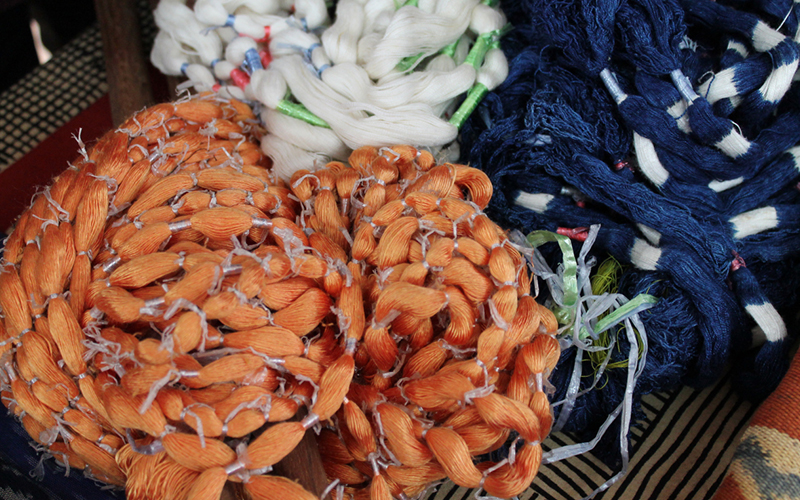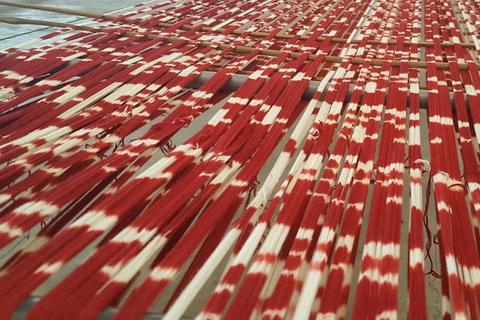
Weaver weaving ikat
Ikat, one of India’s oldest craft traditions, is the art of tying and dyeing the yarn before it is woven. The word Ikat itself is derived from ‘mengikat’, a Malay-Indonesian word that means ‘to bind’.

Patan Patola
Ikat fabrics have always been popular for their distinct style and unmatched beauty. As I was going through my mother’s closet, the making of ikat piqued my curiosity. After some research, I became acquainted with the fact that instead of dyeing the fabric, the yarn is resist-dyed in a pattern beforehand, and then woven in accordance with the design into the cloth. The process is repeated multiple times, depending upon the complexity of the pattern and the number of colours used. The dyeing is always done from lighter shades to the darkest ones. It is therefore a long-drawn process. The design of the end product looks the same on both sides of the fabric. Generally, the core fabrics that are used in Ikat are silk and cotton.

Yarns tied and dyed

Yarns arranged on the handloom

My mother’s Patan Patola Saree

Close up design of the saree
This ikat is a silk double ikat known as ‘Patan Patola.’ It is practiced in Gujarat where the warp and weft yarns are both tied and dyed before weaving. Once a thriving craft, this type of ikat is now very rare and done by only a few artisans.
This Patola, which is almost 30 years old, was gifted to my mother by her aunt. It is a priceless heirloom, which is of emotional relevance to her and also holds a traditional value due to its origin being from Gujarat, her native state.
The silk is smooth and soft and drapes itself beautifully on the body. The design and colours always makes it stand out whenever worn. It can be worn for any occasion when accessorized correctly. It is also lightweight and comfortable, making it a perfect summer wear option especially in Indian weather. The rich lustre of silk also makes it a great festive choice. It strongly reflects the Indian culture due to its remarkable nature inspired motifs including geometrical figurines of parrots, elephants and trees. The combination of colours used makes the saree outstand in room full of people.
Ikat textile has been practiced in India, Indonesia Japan and other Southeast Asian countries for the millennia. Indian heritage Ikat from every region has its unique identity in terms of weave and design. Presently, Ikat is prevalent in Gujarat, Andhra Pradesh and Orissa. While the Patan Patola weave of Gujarat mostly focuses on the double ikat technique, the Odisha ikat can be distinguished by its clarity and precision, and play with different yarns. The Andhra ikat focuses mainly on floral and geometric patterns on cotton, silk-cotton and silk fabrics.
Design
Positive Aspects

The blurriness of ikat
When I hear the word ‘ikat’, geometrical designs in blurry lines come to my mind instantly. This apparent ‘blurriness’ is a result of the extreme difficulty the weaver has lining up the dyed yarns so that the pattern comes out perfectly in the finished cloth. Personally I feel that what one may call the flaws of weaving turns out to be its distinctive beauty.
Although united by a common technique, ikat textiles are astonishingly diverse in their imagery, which ranges from bold geometric compositions to figurative patterns of striking visual and technical virtuosity.
As many designers are working with the artisans, the pleasure is when the weavers are experimenting with the old structure using the designer’s innovative designs. It’s what makes the product authentic and rich with tradition.
Ikat is a fantastic weave whose charm and versatility allows year-round comfort. It has that richness that we seek to attain in our creations. There is a beauty, and originality to this handloom that no power-loom product can attain.
Drawbacks

With the traditional process of making ikat sarees by hand, the process can take up to seven months between two people to complete one length of a saree. To produce a single length of a saree even using the automated process, the numbers of steps involved are 14 elaborate ones.
The complication increases when more colours are used to form pattern.Weaving can be quite taxing, as intricate attention to detail in the adjustment of the yarn is necessary throughout the process in order to maintain the consistency and clarity of patterns.

Ikat weave with various colours in process
Till date, it is a tough replicable process. A weaver starts weaving an ikat fabric in the morning. By afternoon, he is tired and someone else takes over. So, when the full length is ready, it merges the work of so many hands, which may cause differences in the design.
The amount of labour and skill required also make it the most expensive, and many poor quality cloths, which might not even be true ikat, flood the tourist markets.
Mass production is difficult since most of the processes are done manually.
Ikat is the original ‘make-in-India’ craft, which is under threat from textiles woven on a power loom using man-made yarn. Such textiles are screen-printed to look like Ikat, but as they are far cheaper to produce, they are sold for a song. This has affected the demand for genuine tie-and-dyed Ikat sarees. For the uninformed consumer, it is not easy to distinguish between hand-woven Ikat and screen printed Ikat.
Marketability
Ikat as a craft has reached its pinnacle of perfection in Orissa. Ikat Exports based in Bhubaneswar, Orissa is the largest producer of Ikat handloom fabric and other related products.
Global Appeal
Recent trend indicates the demand of hand touch value ethnic ikat adds to one’s wardrobe. It is in attraction of domestic/foreign consumers by the print/press media and other advertising tools.
Ikat fabrics have obtained full recognition in recent international fairs and exhibitions. Indian exporters have diverted their concentration, especially towards ikat textile production to meet the global market. Many designers replicate the look of ikat with printing or a jacquard loom.
Renowned international fashion designers world over like Oscar de la Renta, Missoni and Jhane Barnes have taken inspiration from the Ikat designs and successfully used the same in their works. Silk ikat sarees have given the weave the much-needed global touch – blending various colours, designers have achieved a chic look.

Missoni fall 2019 collection

Oscar de la Renta Spring 2005 runway

Beautiful ikats featured in high fashion. Oscar de la Renta fall 2013 collection
Uses of ikat in the industry:
Apparel
Ikat was limited to traditional saris only but now it has been diversified to many modern wears – from blouses to stretch pants, basically everywhere in the fashion industry. Ikat is more common in womens clothing than it is in mens.

Contemporary ikat
Accessory
Scarves, shawls, and headscarves are all common applications of ikat in accessories. Other accessories like shoes, purses, belts, and other items may also bear ikat patterns, but these designs may simply be printed rather than authentically bunch-dyed.

Ikat footwear
Décor
Pillowcases, sheets, and other bedding products often feature ikat patterns. Traditionally, ikat was frequently used in wall hangings, and ikat patterns are still commonplace on walls around the world.

Ikat pillowcase
Economical Factors
A few different factors impact the final cost of ikat fabric:
Labour: A Patola ikat takes a lot of mental calculations, patience, undivided attention and dexterity of the weaver’s hand. A computerised machine or powerloom cannot be of much help here. This intensive manual labour and the time and effort involved, the price of an authentic Patan Patola saree can range from Rs 1 lakh to a few lakhs.
Sarees made in the Orissa Ikat process are priced anywhere between Rs. 2000/- to Rs. 20000/- depending on the intricate designs and process involved.
Blurriness: Ikats with little blurriness, multiple colours and complicated patterns are more difficult to create and therefore often more expensive. The blurriness can be reduced by using finer yarns or by the skill of the crafts person. However, the blurriness that is so characteristic of ikat is often prized by textile collectors.
Environmental factors
Originally, even the dyes used were of vegetable and mineral origins, prepared from indigo, turmeric, catechu, myrobalan, iron rust and other natural sources. In recent years, the vegetable dyes have been largely replaced by chemical dyes, as they are cheaper and easier to obtain and offer the weaver a larger range of colours, to begin with.
Conclusion
Fashion trends may come nay go but ikat as a craft has stood the test of time. Ikat continues to be designer’s favorite. Ikat weaving is an important living craft tradition of India that involves an incredibly complicated process and the beauty of the outcome vouches for it. Beauty, innovation, sustainability and elegance are the qualities that characterize Indian Ikat fabrics and it will be a sad loss to humanity if this craft has to die out for lack of patronage.
Referencing
Shubh Yatra Magazine. 2020. Ikat Intricacies | Shubh Yatra Magazine. [online] Available at: <http://shubh-yatra.in/ikat-intricacies/> [Accessed 16 August 2020].
World, V., 2020. The Ikat Art On Fabric – Great In Demand And Difficult To Weave. [online] Luxurion World. Available at: <https://luxurionworld.wordpress.com/2016/05/27/the-ikat-art-on-fabric-great-in-demand-and-difficult-to-weave/> [Accessed 16 August 2020].
The Design Cart. 2020. Ikat: The Traditional Handloom. [online] Available at: <https://thedesigncart.com/blogs/news/ikat-the-traditional-handloom> [Accessed 16 August 2020].
Iosrjournals.org. 2020. [online] Available at: <https://www.iosrjournals.org/iosr-jpte/papers/Vol6-Issue1/Version-1/E06012851.pdf> [Accessed 16 August 2020].Utsavpedia. 2020.
Everything About Ikat Or Ikkat From Orissa | Utsavpedia. [online] Available at: <https://www.utsavpedia.com/textiles/orissa-ikat-an-expression/> [Accessed 16 August 2020].
Indoindians.com. 2020. The Story Of Ikat – The Ties That Bind And Weave Into A Beautiful Fuzzy Tapestry – Indoindians.Com. [online] Available at: <https://www.indoindians.com/the-story-of-ikat-the-ties-that-bind-and-weave-into-a-beautiful-fuzzy-tapestry/> [Accessed 16 August 2020].
MV, S., 2020. The Story Of Patan Patola: A Fabric That Never Fades And One Family’S Tryst With Keeping It Alive. [online] YourStory.com. Available at: <https://yourstory.com/2016/10/patan-patola-fabric> [Accessed 16 August 2020].
Blog.vajor.com. 2020. The Story Of Ikat – Vajor Blog. [online] Available at: <https://blog.vajor.com/the-story-of-ikat/> [Accessed 16 August 2020].